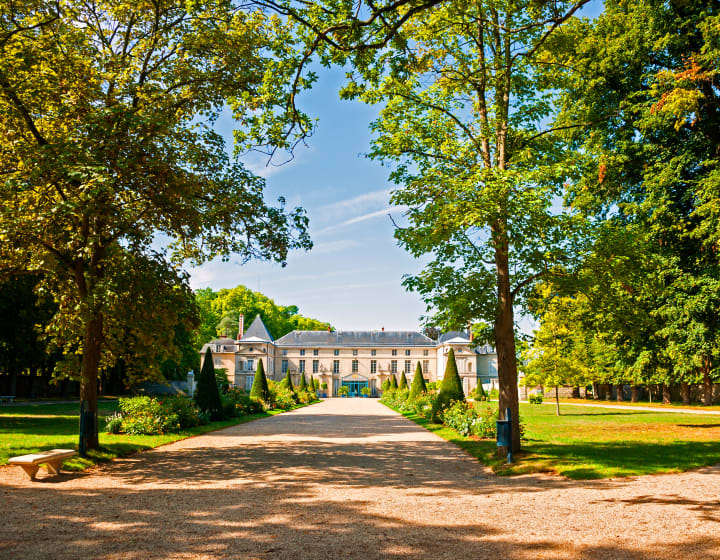The Legend of Napoleon in 10 Mythic Sites
- Inspiration
- Top experiences
- The Legend of Napoleon in 10 Mythic Sites
Paris owes him the creation of the Rue de Rivoli, the Canal de l'Ourcq, and the Palais de la Bourse. A true visionary, the first French emperor, crowned in 1804, wanted to make Paris Region the "capital of the universe." Today, his ambitions remain engraved in the walls and the history of the City of Light. Here's a whistle-stop tour of 10 sites that bear his imperial imprint.
Private life of the imperial couple
While Napoleon may have reigned over Europe, his beloved Josephine reigned over his heart and the Château de Malmaison. The couple moved to this sublime residence, with its private apartments decorated by the celebrated Percier and Fontaine, in 1799. Accessible by RER A from Châtelet – Les Halles, the Château de Malmaison remains a faithful witness of the imperial couple’s domestic life and the habits of Josephine, who remained here until her death.

Farewell to arms at the Château de Fontainebleau
The "true residence of kings," according to Napoleon, the Château de Fontainebleau provided the solemn setting for the Emperor’s moving farewells to his Imperial Guard on 20April, 1814. Set only 45 minutes south-east of Paris, the palace-museum is home to rich collections of personal objects and souvenirs dedicated to Napoleon’s family. While the throne room is the only one in France preserved in its original state.

The last resting place
A haven of peace, where the Emperor liked to come to hunt between military campaigns, the Château de Rambouillet, 50 kilometres west of Paris, was the site of some of Napoleon’s final moments before his exile in 1814. Don’t miss the bathroom, a neoclassical gem, which has preserved its magnificent décor, inspired by antiquity, and the original bathtub

Escape to the Trianon
The Sun King isn’t the only illustrious figure associated with Versailles. Stripped of the Château de Malmaison after he divorced Josephine, Napoleon had the Grand Trianon renovated in the Empire style, so he could use it as his country retreat.

Home of the greats
In 1806, Napoleon consecrated the Pantheon, in the heart of Paris, as the official mausoleum for dignitaries and officers of the Empire. In doing so, he transformed this monument into the distinguished hall of memories that it remains today. Here lies Voltaire, Rousseau and Victor Hugo– though not Napoleon, who is buried under the Dôme des Invalides.

The triumphal armies
The most famous triumphal arch in the world, a symbol of the grandeur of Napoleon's reign, the Arc de Triomphe was begun in 1806 and completed in 1836. The archway, overlooking the Champs-Élysées, has the names of 658 admirals, field marshals and generals of the First Empire engraved on its stone façade.

The Army Museum's priceless imperial collections
To relive Napoleon’ battles, head to the Musée de l’Armée in Paris, which houses, since 1905, an exceptional collection of objects that belonged to Napoleon, as well as the uniforms and weapons of his soldiers. Make sure to visit the statue of the emperor, presiding over the main courtyard.

Napoleon, the man behind the creation of the Legion d'honneur
The Légion d’Honneur, a prestigious order created by Napoleon to honour soldiers and civilians of special merit, has been awarded to some of the greatest names in French history, including Jean Moulin, Lucie Aubrac, or Jules Verne. And since 1925, the order has its own museum, located just opposite the Musée d’Orsay, where the history of the order is retraced, alongside souvenirs from Napoleon’s reign.

War spoils
Before holding the " Mona Lisa," the Louvre was known as the Napoleon Museum and was dedicated to artistic treasures from across Europe, seized during the Emperor’s military operations. From his Egypt campaign to his coronation at Notre-Dame Cathedral, Napoleon also inspired many of the artists of his era, including the painter David. Make sure to visit his monumental painting "The Coronation of Napoleon", one of the Louvre’s most famous works.

Under the celestial vault of the Dôme des Invalides
After life in a gilded Empire, Napoleon now lies under the golden cupola of the Dôme des Invalides. In line with his grandiose ambitions, his tomb is of monumental proportions, surrounded by mosaics representing his political oeuvre and military victories.

Vous aimerez aussi
- Copyright image: © Sina / Adobe Stock


